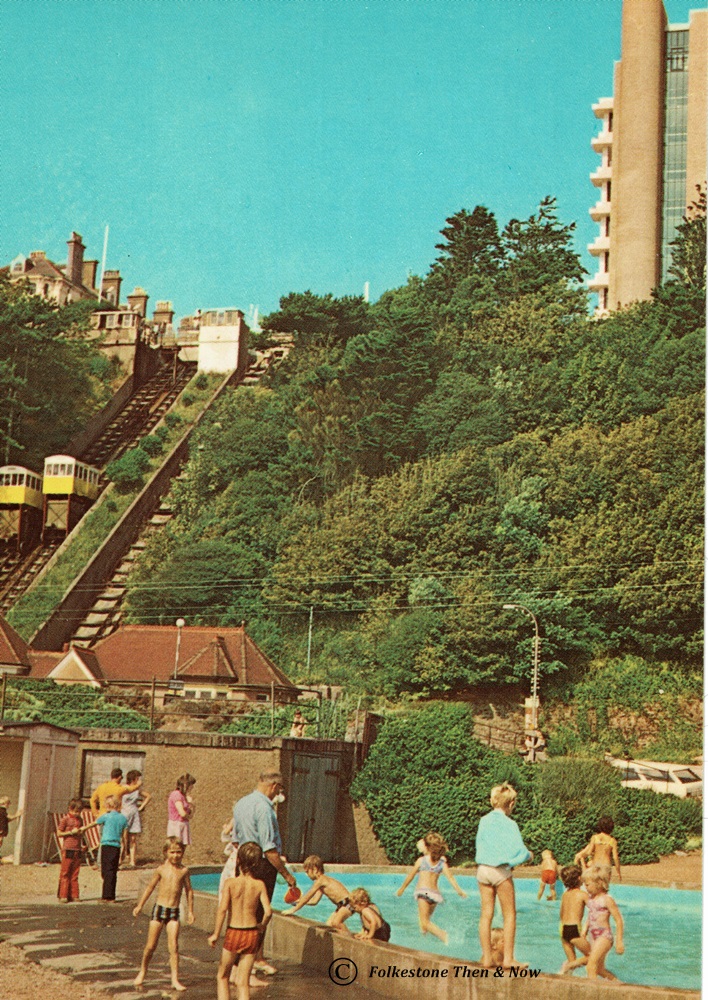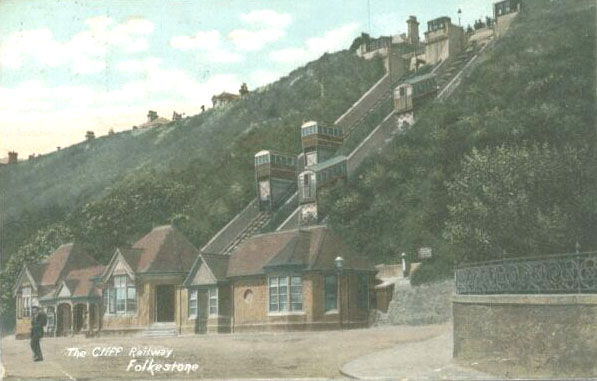
The Cliff Railway as it was called in 1904
This is how the only remaining lift looked in 2022, out of service once again, and with no funds to fix it. However, now they are hoping to sell the condos on the beach, the money has been found from various places, and the two carriages have been taken away for restoration, and the mechanism is in the process of being fixed once more. Hopefully once it is done, it will bring in enough money year round to be self sustainable.
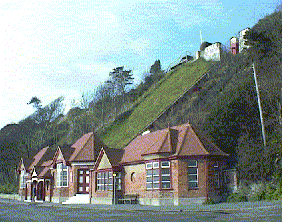
Here is a novel picture of the Leas Lifts showing how they will look again soon. (Wait for this page to fully load, and you will see it working!)
I found this photo on the Shepway district Council website, where they had the history of these lifts, however, I can no longer find it there.
This is what was known as the Metropole Lifts or West Lifts. It was built for the convenience of the patrons of the Metropole and Grand Hotels.
All of Folkestone's cliff lifts were operated by water.
The top end of the same lift taken just three years after it was built in 1907
This is the lower end of the Sandgate Lift which ran down from the Leas.
This one wasn't in operation very long. Just from 1893 to 1918.
The Sandgate lift again, taken from above.
Taken from below. At the top you can see the Martello Tower that last time I looked was hidden completely with foliage.
This was the childrens' paddling pool that was on the beach near the lifts in the 1970's, by all accounts it was pretty popular with the children and their parents, but it was taken away, not sure why. It is now the site of the new luxury flats they are building all along the beach, but in 2025 there is only one block built - I haven't heard how well they are selling.
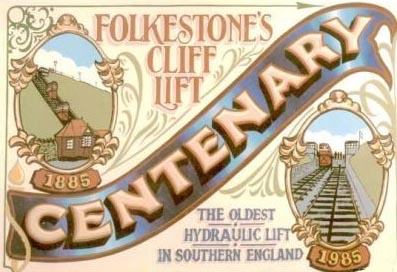
How the lifts looked when both tracks were in operation.
Isn't that an interesting wall on the bottom right of the picture? It has metal scrollwork sitting atop the stone.
It's about time we saw the other end of the East End Lifts. This is how they looked in 1923.
This one was sent to me by a fellow named Ross. Judging by the car, I would guess it to be either 50's or 60's. The lift on the right was working still, so it couldn't have been after 1966.
Oh my older sister had to wear a hat like that when she went to the County Grammar School! She hated it, and called it a 'Poe hat' :-)
This photo is a lot older than those days though, so these girls probably had to wear them even when they were not in school!
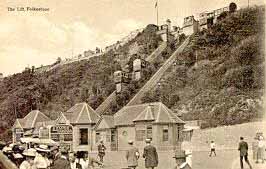
I don't have a date for this one, but it was of an age where they had buses. This bus had 'Lyons' written on it.
These East lifts have definitely had more photos taken of them than either of the others, but that is probably because they have been in operation a lot longer.
I have seen quite a few photos showing that they planted trees between the two sets of tracks, but imagine they would have had to pull them out when they grew to any size.
Another one of the Majestic lifts and Madeira Walk on the right.
This one is dated 1915, the year my mother was born in Etchinghill. No, not in the workhouse there, they lived in a cottage in the village.
And back over to the Majestic lift again with a couple taking a stroll along Madeira Walk in 1911.
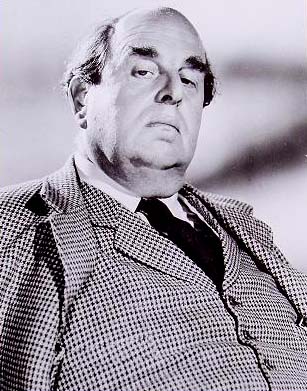
Actor Robert Morley, who spent part of his childhood in Folkestone said in his autobiography 'A Musing Morley', "What gave Folkestone, and in a sense myself, character, were the cliff-hangers, the lifts. I travelled in them on an average at least once a week, always my heart was in my mouth.
It is this sense of danger that makes life sweet. I am numbed by the blasÚness of astronauts, those laconic voices revealing their boredom. Even their names appear to me subnormal - Pete, Greg. My sister, who is called Margaret, and I, who was christened Adolf, used to scream loudly just before take-off. Count-down was signalled by closing the sliding doors, and then there would be the terrifying surge of water. We would look up at the seagulls circling far, far overhead, at the tiny figures in the car which was about to crash down on our heads, and scream. Of course, it never really hit us. We used to pass the car halfway. Sometimes it would be quite full, whereas our lift would contain only my sister, myself and our governess.
I always wondered whether they adjusted the weight of the water, how it was that we rose and they sank without unseemly haste, while the balance was so unequal. At the top, splash-down was always carried out without a hitch. The car was accurately positioned to enable us to step out of it and hurry home to tea."
Home
|
I added this one because I have never seen these buildings in the foreground before.
They couldn't have been changing huts, because they had no doors on them
Same paddling pool as above, different angle. How long has it been now since crowds of people were able to flock to the West Beach like that? Or even access it via the lift for that matter. It looks as if it was well used, yet it was closed long before they started building. It was a safer place for toddlers to go than in the sea, especially on the West Beach where the shingle moves with the tide and forms ridges under water, where a child can wade out then suddenly be out of their depth when they step off a ridge.
Heard from Alan Taylor about this one. The reason this particular lift closed was because it couldn't compete with the motor charabancs which started running from Sandgate to Folkestone.
Thanks Alan! :-)
Alan told me the building on the left was a tea chalet, and the strange one on the right was a shelter
Page Updated March 23, 2025
|
I would guess this photo to be early 60's, and under a magnifying glass, I think it has the price of 4d on that sign at the top.
If you have your own memories of the Leas Lifts, please be sure to share them with us by jotting them down in the book below.
Just had an e-mail from Ann & Stan Finney who reckon the man is selling ice cream.
Which started all these questions in my mind:
1. How was it served? Had they invented cornets or wafers by then? Or was it served in little dishes with spoons?
2. Did they have different flavours? How did it taste?
3. Was the cart just a big box with ice & salt inside, and the ice cream lasted as long as the ice did? Refrigerated carts hadn't been invented yet had they?
I just did a search and came up with the following:
The commercial harvesting of ice in cold climates and its transport to population centres was a growth area from the early nineteenth century. This ice trade made large volumes of ice available at a realistic price and it became possible for ice cream sellers to offer a taste of ice cream to the ordinary person. Ice was sold on glasses which were wiped clean and re-used. These glass "licks" remained in use in London until they were made illegal in 1926 for reasons of public health. Ice cream edible cones were first documented by Mrs Agnes Marshall in her book Fancy Ices of 1894.
This photo is 16 yrs older than 1926, so the question is, was he selling ice licks? (shudder)
You see so many photos of the Cliff Lifts from the bottom, so I couldn't resist buying this card which shows how it looked from the top.
Down below you can see Marine Parade and the Bathing Establishment. In the bottom right corner, you can see lines and lines of what are probably towels drying in the sun.
What a job it must have been in those days, no washing machines or dryers.
The fastest way to get from the top of the Leas to the West Beach, the Coastal Park and back again has always been via the cliff lifts. However, these days, there is only one left, at the east end of the Leas, closed for a while, and not for the first time, due to lack of funding.
There are only a few of these lifts left in operation in the country, and not all powered by water and gravity as were all at one time, Folkestone alone had four of them.
One car at the top is filled with water underneath until the combined weight of the passengers and water is greater than the one below, it then descends, causing the one below to be pulled up. There are many websites explaining the mechanics of it better than I can. Just do a search.
The lift above was built in 1885, and a second track beside it holding another two cars was closed in 1966. The other two sadly are also long gone. The Metropole lifts at the West end of the Leas was in operation from 1904 until the last war, when it was used by the troops, and unfortunately was damaged too badly by 1940 to repair, so had to be dismantled. The other one began even further west on the Leas in 1893, and ran down into Sandgate until 1918.
So Folkestone's last funicular lift has been given a reprieve, as it is currently under repair, but I urge residents and visitors alike to use it as much as possible, because it cannot be run at a loss.
Here is a photo of the East lifts from the beach, showing the usual assortment of grossly overdressed people getting some sun on the few pieces of exposed skin. I bet there wasn't a lot of skin cancer back in those days! Just above the beach, you can see a long roof, possibly a restaurant or something with a tea garden outside?
One more of the East Lifts. Don't you love the man in the straw boater? Perfect for the seaside! :-) This photo is courtesy of Bryn Clinch, who tells me that it was written and sent by his Great Uncle Phil Toms, who sent it to his sister and brother-in-law, who were Bryn's Great Grandparents. His Great Uncle Phil had a removal business in Folkestone


This is Croft House on Sandgate Hill taken in 2023. Barely recognisable as the lower Sandgate Lift Ticket office.
My guess is that this card dates from 1985! :) It was the anniversary of the double lifts at the East end of the Leas, but there was only one left there to celebrate by then.
Looks like the original wall has survived at the back, but by 2022 the part with the metal scrollwork has been demolished to make way for the condos they are building on the beach.
I swear someone goes through this website, and anything I remark on, saying I like it, or it has character, they immediately pull it down!
This is the ticket office of the East End Lifts before they added the second pair, necessitating an extension being added to the right of the building as well.
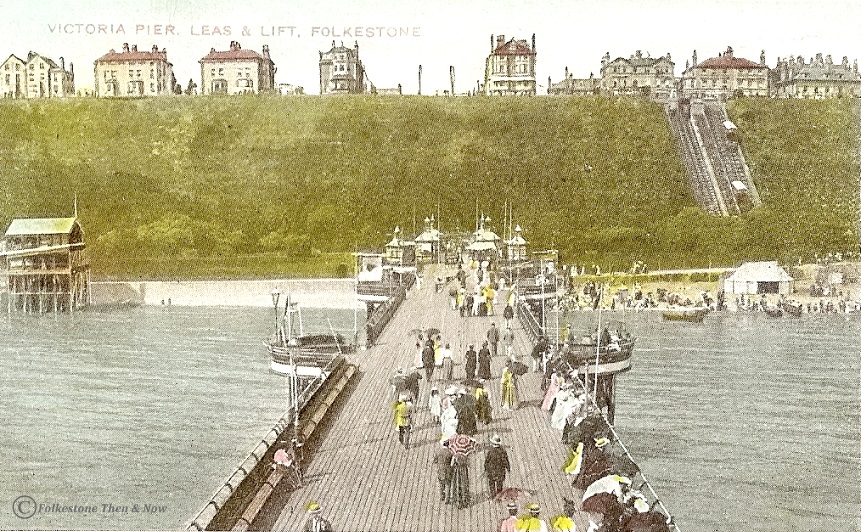
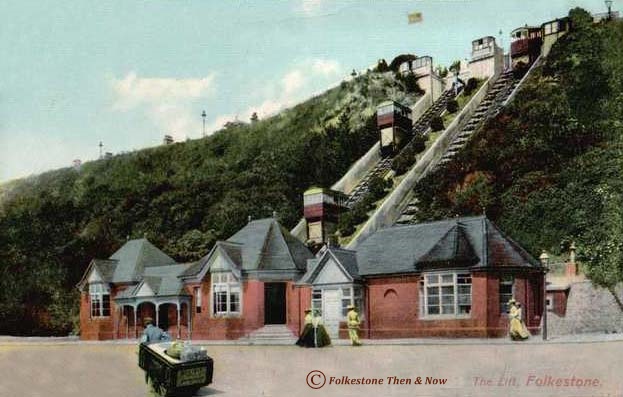
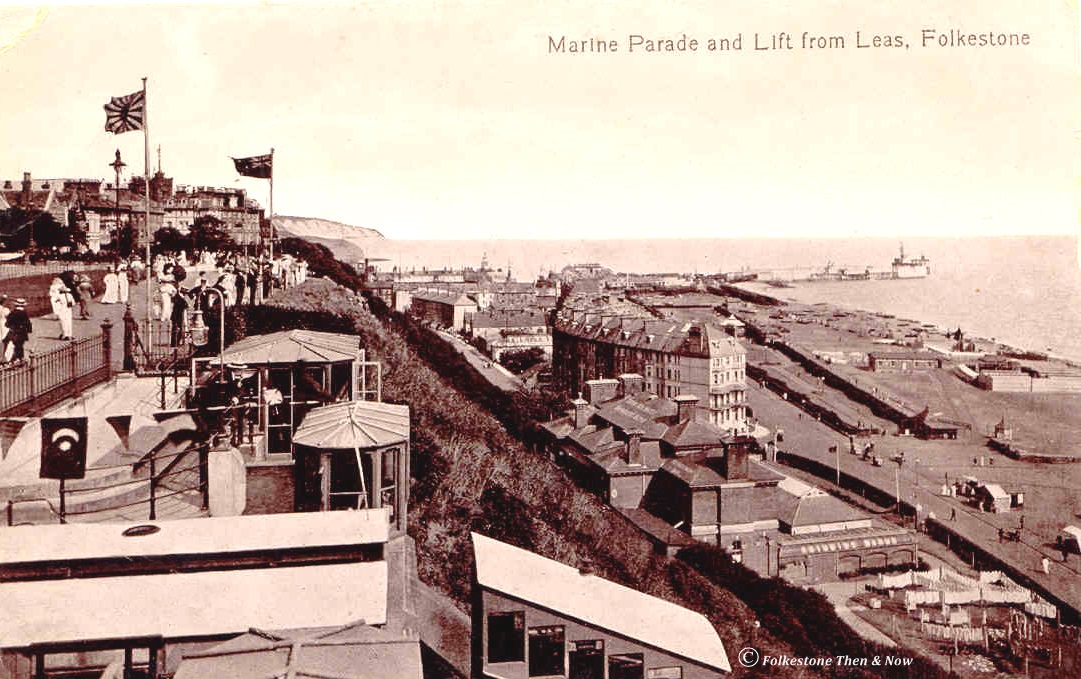
This one gives you a good idea of the location of the Victoria Pier and the Switchback Railway when you see it in conjunction to the Lifts. Lots to do down there in those days eh? That was only a fraction of things to do if you move a little more to the right too. Did you know you could even go to Church on the beach back then? Services were held in a tent nearby on a Sunday, well you sometimes needed to repent your sins after ogling the girls down in the mixed bathing area! If you were lucky you got a glimpse of a bare ankle!
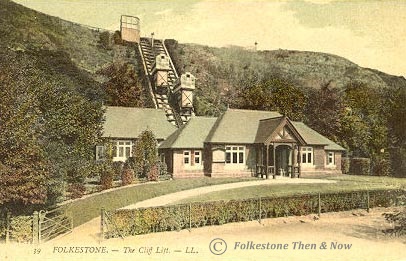
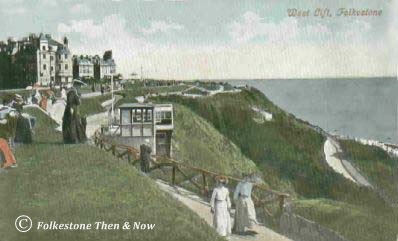
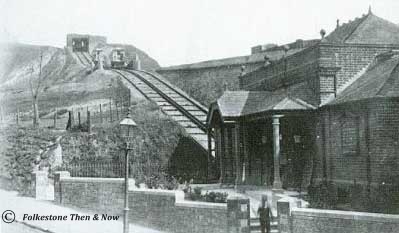
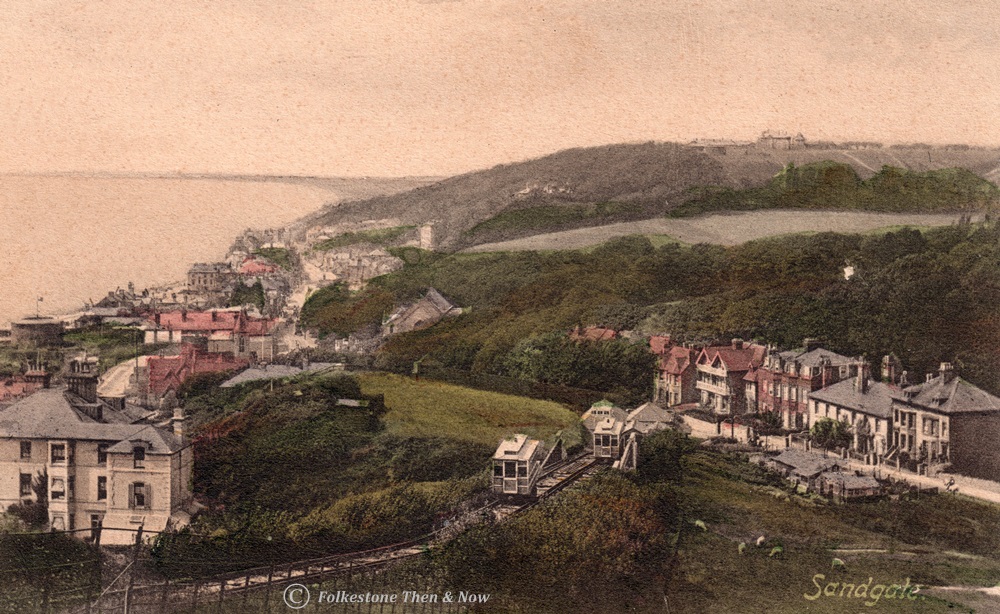
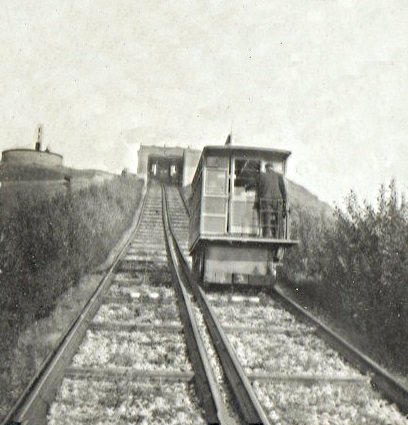
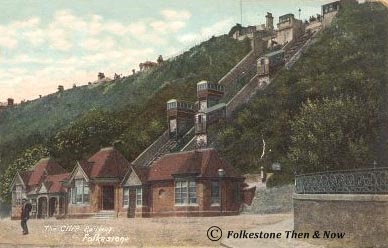
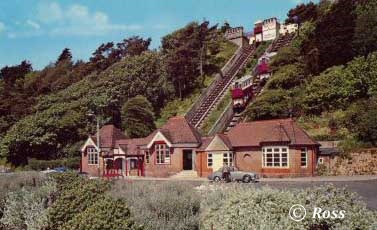
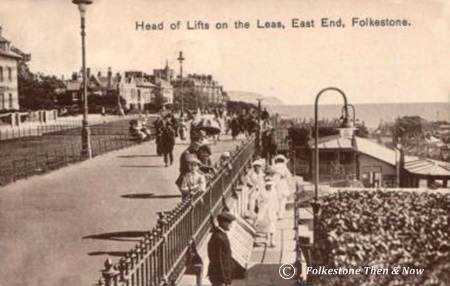
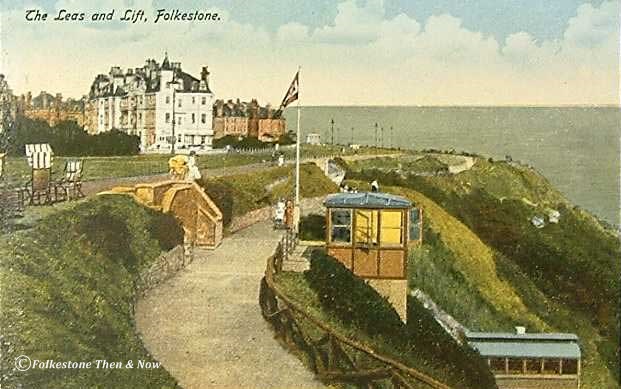
Back over to the Metropole Lifts again. What a shame that this one is no longer there.
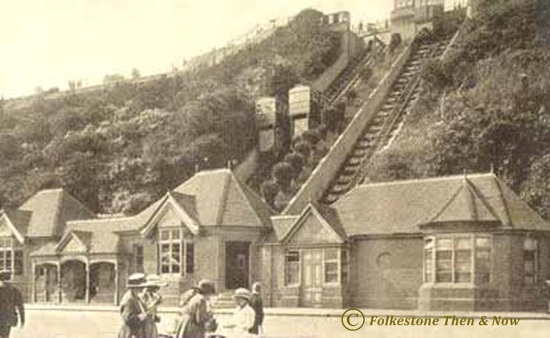
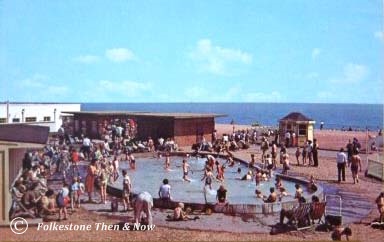
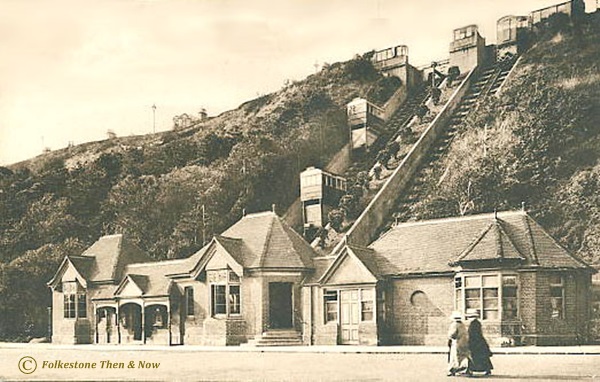
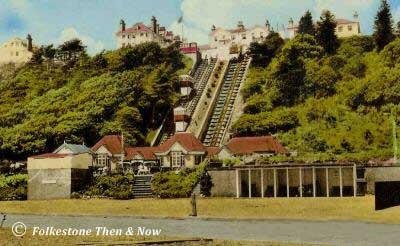

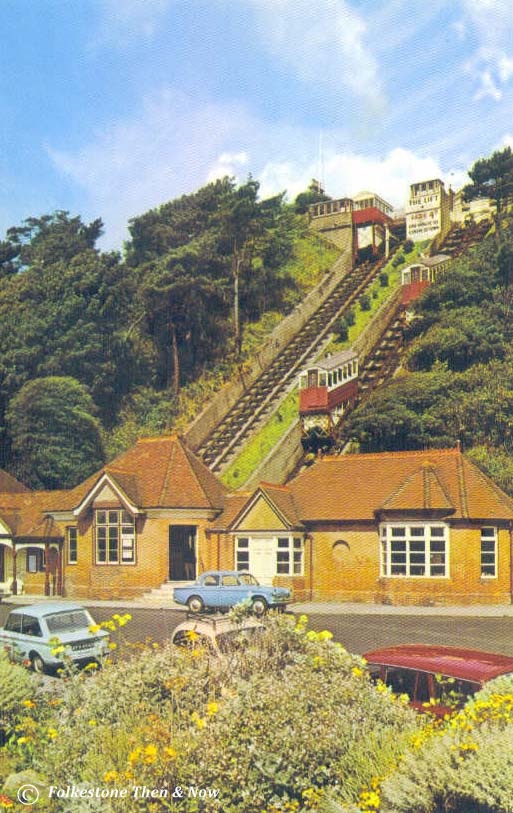
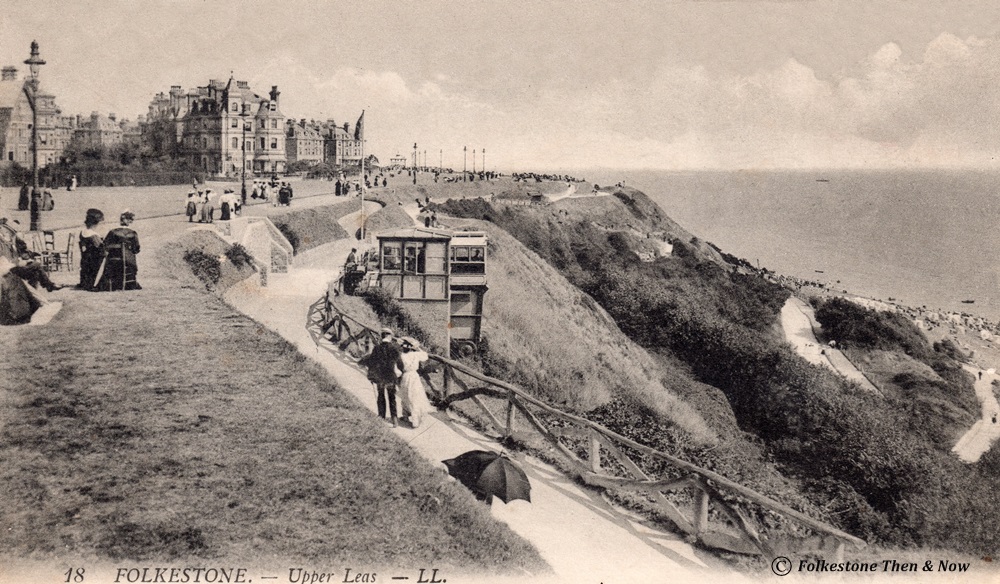
C.jpg)
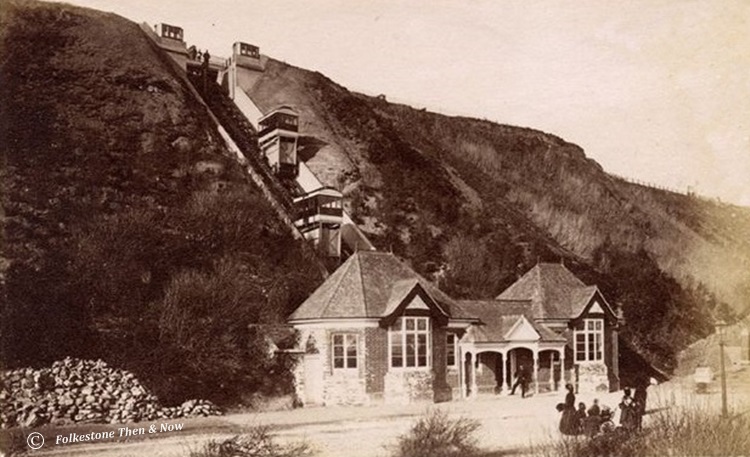
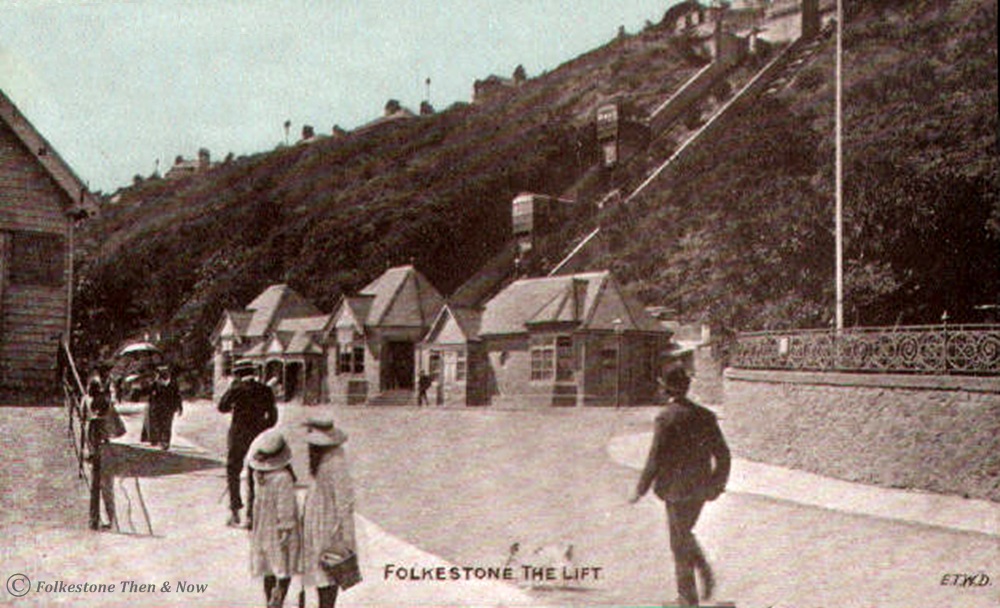
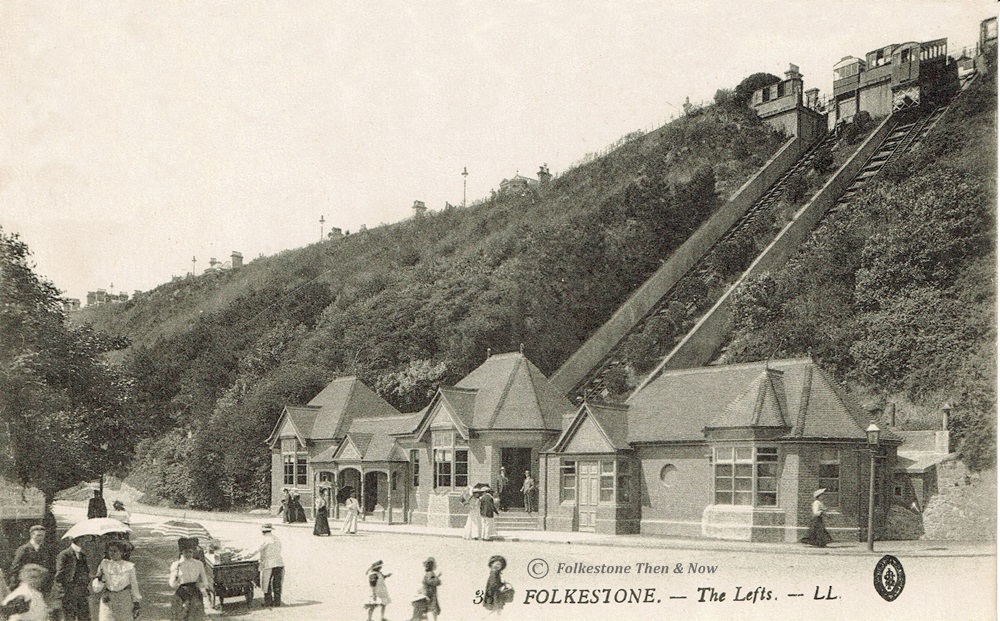
A nice one showing the lift working with two little girls dressed alike in their best Sunday hats.
This one dates from 1916, and although you can't see it very clearly, it looks like a very small house directly behind the right side of the ticket office. Did someone maybe live on the premises I wonder? If you click on the above photo, you can not only see a bigger version of it, but there is also a link to a You Tube video of the East Lifts in operation.






















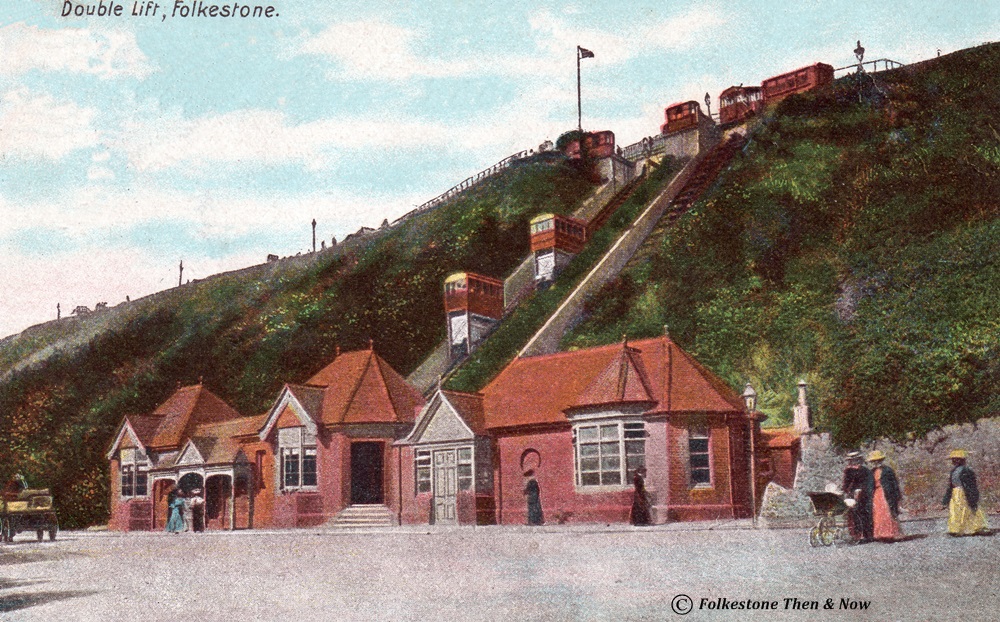

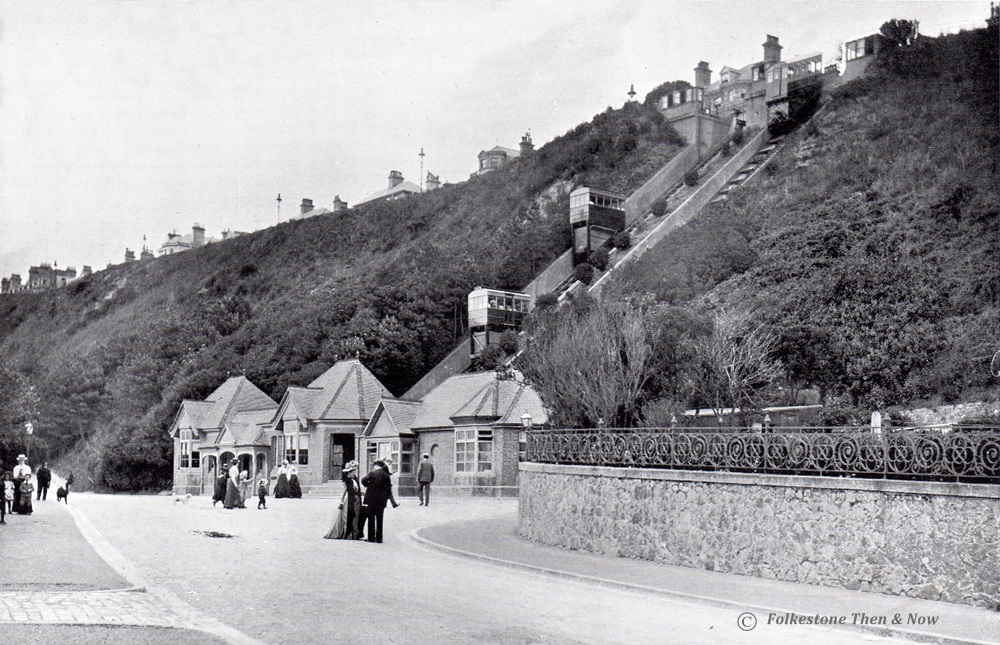

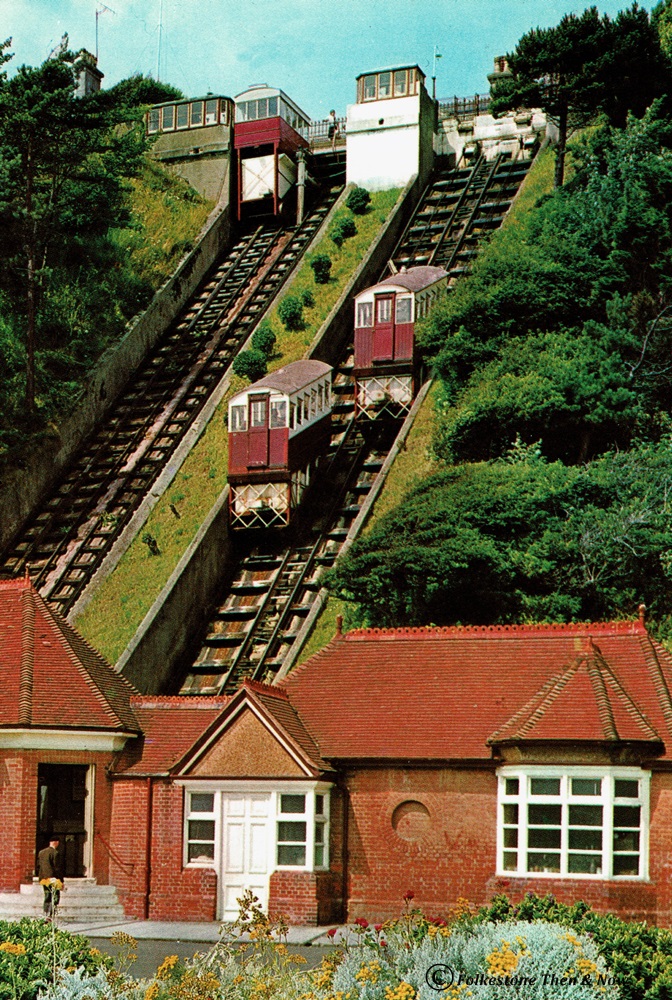
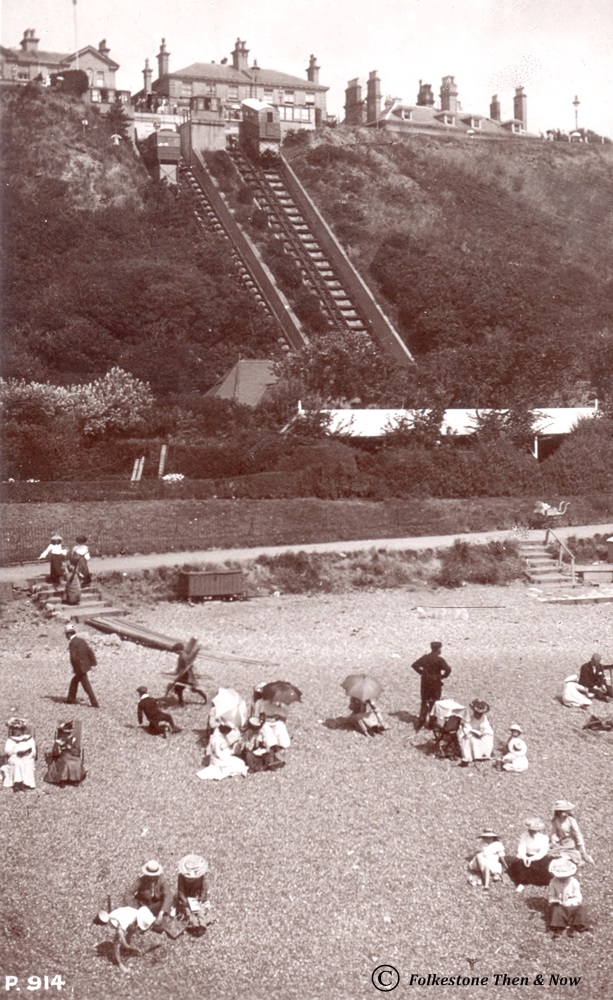
This one was originally sold on the Flushing Line ferry
A nice one from the days when both sides worked and both earned enough to keep themselves maintained.

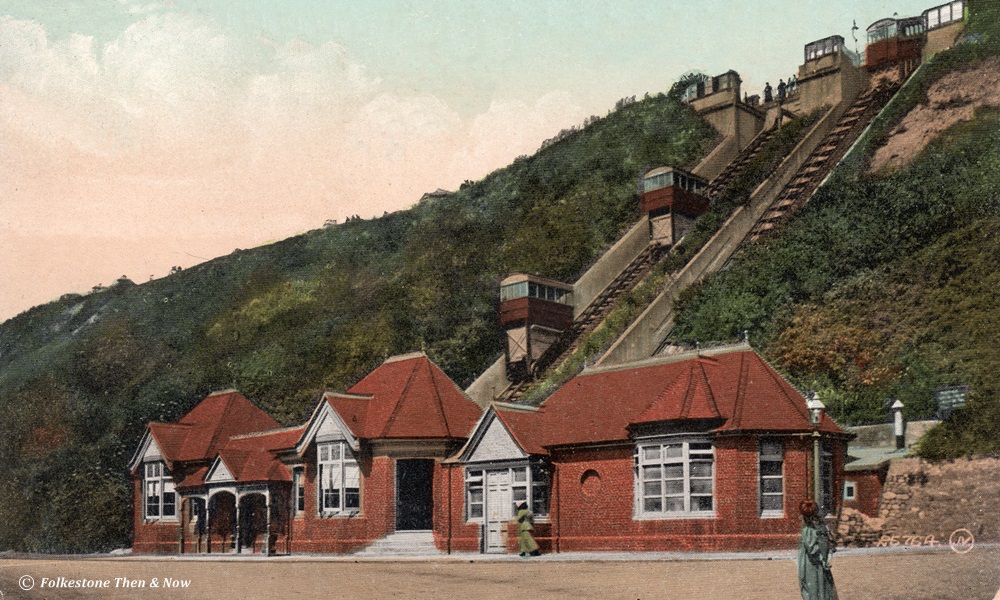
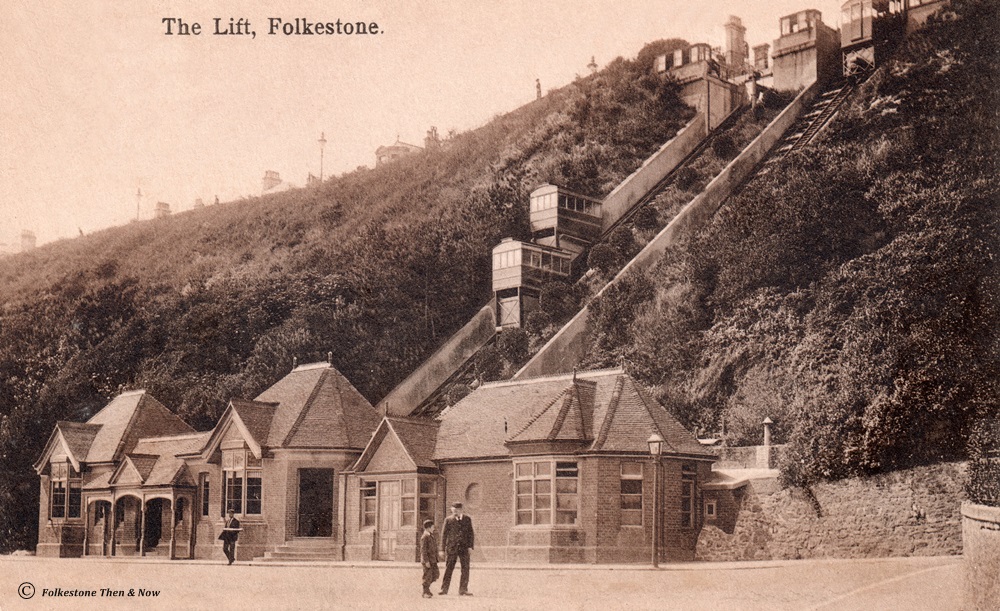

Not much difference in these two except the colour, the image on the left dates from 1910, and 1908 on the right
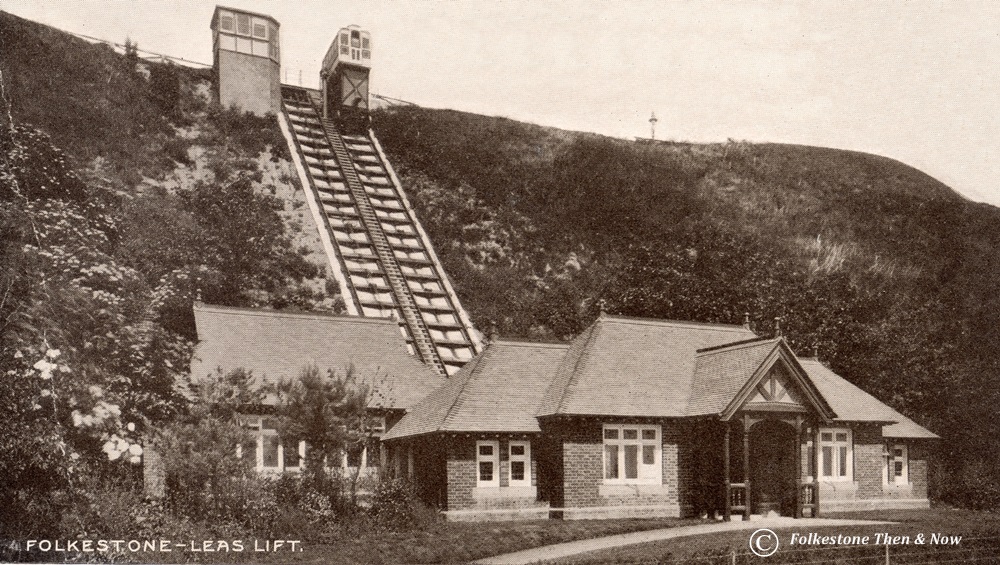
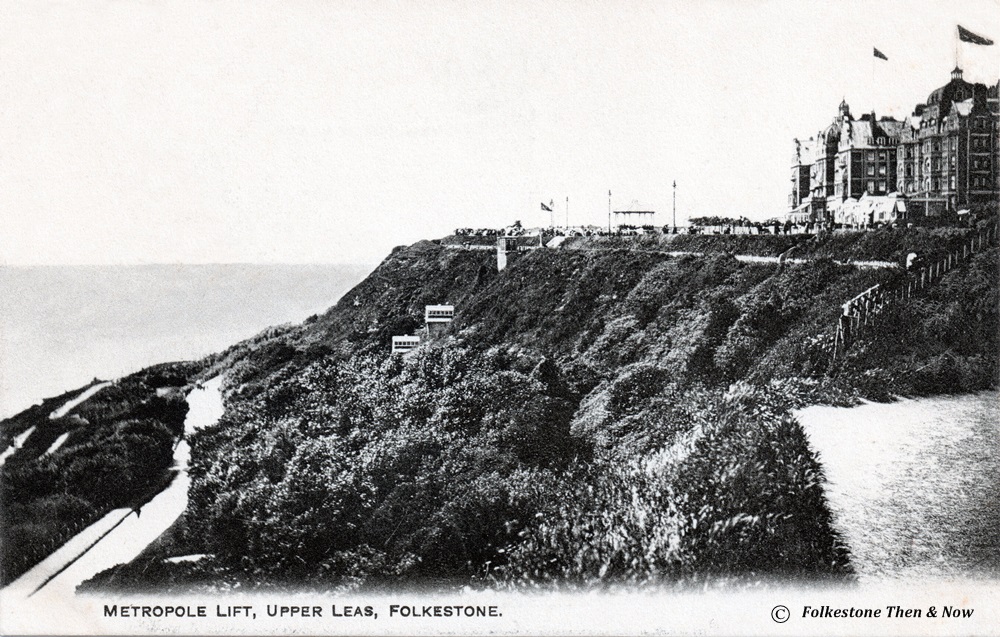
Both of these are of the Metropole Lifts, the card on the right shows you exactly where they were located in front of the Metropole and Grand Hotels.

C.jpg)
I already added this one to the page further up, but thought you would like to have a closer view of the Metropole Lifts

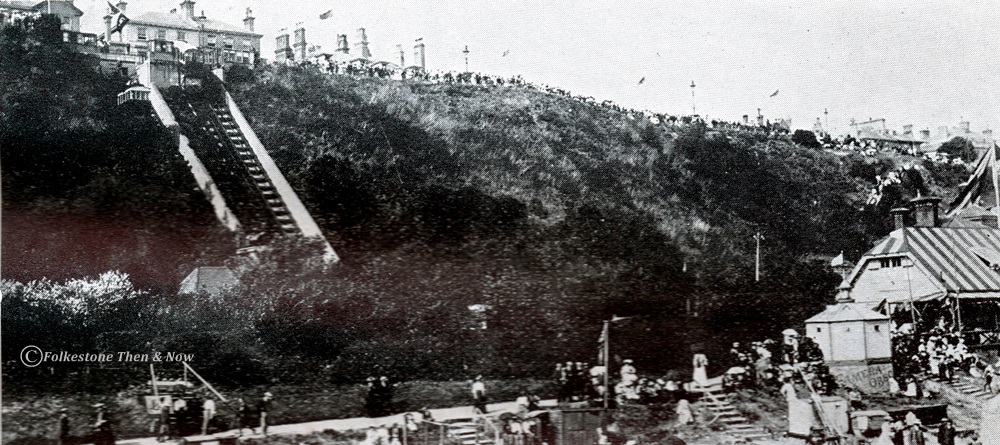
It's a shame this one isn't coloured, there is so much going on here, hordes of people both on the Leas and on the beach. Up on the walk there is someone painting portraits. To the right there is a Camera Obscura, plus what looks like a refreshment kiosk next to that. Then of course right behind us is the Victoria Pier with a show at the end, and the Switchback Railway if you haven't eaten too much ice cream, because it had the effect of going fast over a hump back bridge - over and over. At one point there was also a roller skating rink next to the pier as well, where you could obtain free skating lessons. A little tricky in a dress that went to the floor, but you needed a bit of excitement on holiday didn't you? If you would like to see the Pier and Switchback, plus the roller rink, check their page from the Index.


A more modern postcard, but most of it is just as obsolete. They assure us the Lift will be back, but the second side will never return. The pier in the distance is still there, but the name has been changed to the Harbour Arm, and there are no cranes on it now that it is no longer a working pier - even the lighthouse on the end is now a Champagne Bar, and in the summer months you can walk along and try the food from lots of vendors from temporary kiosks. They also have an outdoor cinema on there from time to time. Also, if you are lucky, you will get a glimpse of the Iron Man by Antony Gormley in the loading bay below the pier. He is standing there, naked as a Jaybird, looking out across the harbour. Everything else on the card has been demolished.
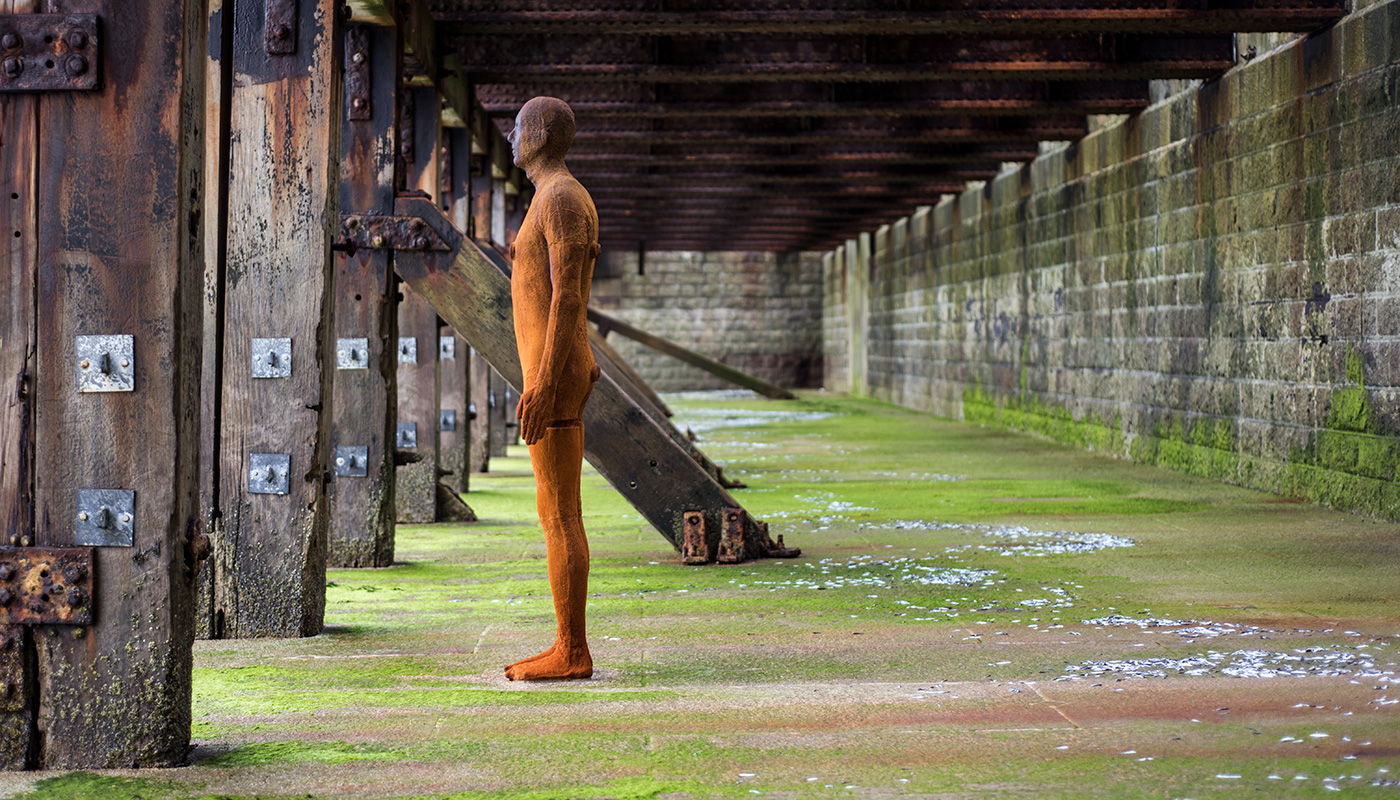
The Iron Man by Antony Gormley.
